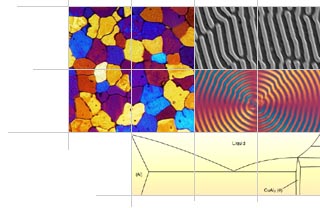Micrograph Library
Browse the libraryAdvanced searchSystemsCompositionsTechniquesKeywordsPhase diagramsHelpPreferencesAbout the micrograph libraryTerms of useContribute micrographs!FeedbackLinksCredits Print this page

Full Record for Micrograph 150

[339 KB]
View micrograph
.. in new window
View micrograph and record
.. in new window
You can also view and download the micrographs on Flickr
- Micrograph no
- 150
- Brief description
- Alumina-zirconia-silica (AZS) refractory brick
- Keywords
- alumina
 , aluminium
, aluminium  , brick
, brick  , ceramic
, ceramic  , dendrite
, dendrite  , eutectic
, eutectic  , glass
, glass  , oxygen
, oxygen  , silica, silicon
, silica, silicon  , zirconia, zirconium
, zirconia, zirconium - Categories
- Ceramic
- System
- Al2O3-ZrO2-SiO2
- Composition
- Al2O3 50, ZrO2 32, SiO2 15 (wt%), + trace alkalis
- Standard codes
- Reaction
- Processing
- Melt oxide powders in electric arc furnace above 1800C , pour into moulds.
- Applications
- Liquid contact areas of glass tanks.
- Sample preparation
- Polished but unetched.
- Technique
- Reflected light microscopy
- Length bar
- 300 μm
- Further information
- On cooling the ceramic liquid precipitates primary ZrO2 dendrites (white), grey corundum (Al2O3) and a ZrO2/Al2O3 eutectic while glass solidifies from the remaining liquid (slightly darker than the corundum). The composition of this glass is carefully controlled so that it is fluid enough to accommodate the tetragonal to monoclinic ZrO2 transition n heating the glass tank to use temperature. The AZS microstructure is carefully designed so that the alumina dissolves in the tank glass (soda-lime-silica, SLS) leaving a viscous alumina rich layer which protects the refractory. It can survive 12 years continuous use in direct contact with fluid, corrosive SLS liquid at temperatures up to 1500 °C.
- Contributor
- Prof W E Lee
- Organisation
- Department of Engineering Materials, University of Sheffield
- Date
- 10/05/02
- Licence for re-use
 Attribution-NonCommercial-ShareAlike 4.0 International
Attribution-NonCommercial-ShareAlike 4.0 International

